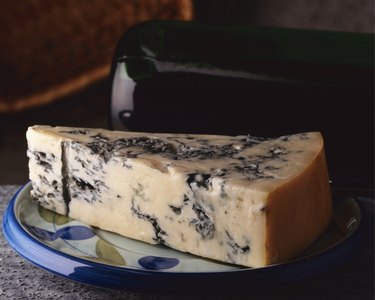
Fungal infections come in many forms, including yeast infections and athlete's foot. A body fungus usually thrives in warm, moist areas and can attack people with weaker immune systems. They're also contagious, which is why you should wear flip-flops in the gym shower and not share hair brushes. Your diet can exacerbate a fungal infection, particularly one known as candida, but no one food is the reason you acquire it initially.
Types of Fungal Infections
Video of the Day
Fungal infections come in multiple forms and can affect you internally or externally. Tinea, commonly known as ringworm, affects the hair, skin or nails and usually spreads from a pea-sized red dot into a circular rash. Athlete's foot is a fungus that affects the soles and between the toes; jock itch penetrates the groin and upper thighs. Candida is a yeast that's a type of fungus. It naturally occurs in the mucous membranes and on the skin, but an overgrowth can cause thrush -- white patches in babies -- and vaginal yeast infections, along with a host of other symptoms. Pityriasis versicolor lives on human skin. This fungus expands over the chest, shoulders and back.
Video of the Day
Rashes, cracked skin, itching and overall malaise are indications that you are experiencing some sort of external fungal infection. Candida infections can also manifest as digestive distress or other ailments if the fungus enters the bloodstream and infects the whole body.
Moldy Foods
Molded food, like a rotten orange in the refrigerator, can cause you to become sick if you eat it -- but not usually with a fungus. These microscopic fungi can form on food, especially if it's old or stored improperly. Mold can cause allergic reactions and respiratory problems and, in some cases, poison people with mycotoxins -- toxic fungal compounds that form primarily on nuts and grains. Molds and fungi can be beneficial in producing tasty foods, such as in blue-veined cheeses or edible mushrooms. Eating moldy food is most likely to result in a case of unpleasant food poisoning.
High Sugar
A high-sugar diet won't guarantee you'll develop a yeast or fungal infection, but it can exacerbate it. Yeast thrive in sugary environments, including one created by meals that contain a lot of refined-carbohydrate foods -- such as bread, white rice, desserts and soda.
Limit or completely avoid all of these simple carbohydrate foods and stick to mainly fresh, leafy vegetables, nuts and lean proteins to help starve a yeast infection. Consult with your doctor, too, as you may need medical intervention.
Fighting Fungus
To discourage the overgrowth of yeast, eat plenty of foods that contain healthy bacteria. Yogurt and other fermented food with probiotics, such as kefir and kombucha, may be protective. For an external fungus, such as tinea or athlete's foot, your diet isn't as much of an issue, but good hygiene helps. Wearing clean, dry clothes and drying completely when exiting a pool or bath go a long way in preventing infection.